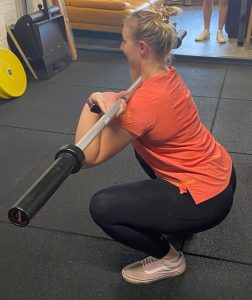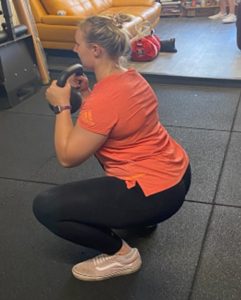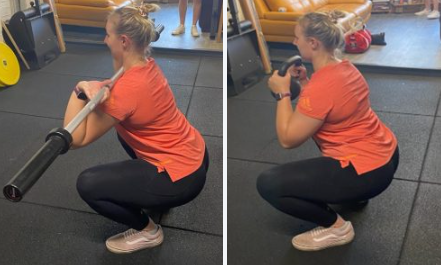Guest article by Garry Jackson, Performance Manager for the British Army Weightlifting Team
Leg strength is a key element of weightlifting. This is achieved through the use of the squat. The aim of a squat is to go from a vertical position to as low as possible, back to a vertical position.
How this is achieved will depend. Yes! I said it, it depends… it depends on the demand of the task, the athlete’s ability and, the purpose of the task. If you’re learning to squat so you can get up and down in a chair, the way you train the squat will be different to how a weightlifter will train for a squat.
I find it hard to understand why there are still debates over how as humans, we should do this. We have been squatting for thousands of years and we still manage to disagree over a natural movement. I say natural, for most it is a lost skill.
Just look at nature and you will see the natural order of things – variation!
Olympic Style Squat
Despite this variation, I am going to tell you that if you want to be a weightlifter in the sport of weightlifting, then you must do this one way and one way only… cue the stunned silence, the quizzical frowns or the chuffs of disagreement.
Weightlifting requires the legs to do the vast majority of the work and therefore leg strength must be developed as part of the training process. Plus, in order to receive the bar in the bottom position requires a large degree of flexibility, especially if the bar is at maximal weight. Note, the more flexible you are, the greater opportunity you have for both depth and speed under the bar. ‘Speed’ is a key element if you are to reach your full potential.
A weightlifter must train the squat with the knees forward over the toes or intentionally towards the toes, hips as low as possible (not so low that you lose tightness in the back) and the torso near vertical (upright). Depth of hips is dictated by the flexibility and mass of the muscle in the legs, length of the lower and upper leg and mobility of the hips and ankles.
Note, when I say knees forward, I am trying to influence the angle of the shin that is influenced by the ankle joint. Ultimately the aim is to close the knee joint as much as possible so that the hamstrings touch the calves.
How this looks will vary for each athlete.
Now, you may want to squat like a powerlifter typically does or how some coaches will teach the squat. For example, knees back toward the ankles and the hips back with a significant forward lean of the torso. You will invariably realise that this is not optimal or efficient for receiving the bar for a Clean and Jerk or Snatch (AKA classic lifts). Sure, you can receive the bar with this type of squat, but you won’t for true maximal or heavy weight.
The foot width and foot angle will also vary from athlete to athlete. What must remain common on stance, is the knees and the thighs in line with the feet. No excessive valgus (in) or varus (out) knee alignment. Always keeping the joints aligned will optimise performance and reduce the risk of injury.
What is true for all types of squats is the torso. The amount of load or angle of inclination does not change the need for correct back posture. Either global extension or flat (commonly termed as ‘neutral’). The term neutral in itself is also up for debate… but not today.
Notice how I haven’t even mentioned bar position. Now that I have, regardless of the squat variation, the principles are the same. Knees forward, hips low, torso upright, in a position of stability and balance – SIMPLES!


If an athlete is unable to squat as desired in the Olympic-style squat, then the priority of training is to establish their style of squat to maximise their potential for strength and results in the classic lifts.
How Much Leg Strength is Needed for Weightlifting?
Now we have determined how to squat for a weightlifter, we move on to strength. How much leg strength is needed?
This will depend on the weight, technical ability, current strength of the athlete, the length of their levers and their style of lifting and training cycle – all of which will dictate where and how much you focus on leg strength.
A target number for a squat is not necessary for a weightlifter. I will generally use their current results in the Snatch, Clean and Jerk to determine how much leg strength is needed.
For example, if someone is squatting 5 kilos over their current Clean, then perhaps more leg strength is required. Or if they are squatting 50kgs over their current Clean, then perhaps more focus is required elsewhere.
For a stats and figures kind of coach/athlete then use ratios to determine the balance of strength:
- Snatch relative to squat 60% – 64%
- C&J relative to squat 77% – 81%
If an athlete is lifting more than the percentages in the classic lifts, then you probably need more time on strength, whilst maintaining technique.
Example: Athlete A has a 1RM squat of 120kg, with an 85kg Snatch.
- 85/120×100 = 70.8%
If you are lifting less than the percentages in the classic lifts, then you are probably strong enough to lift more, but lack technique or speed-strength.
Example: Athlete B has a 1RM squat of 175kg, with a 120kg Clean.
- 120/175×100 = 68.57%
These ratios are a guide and the variables mentioned must be considered in tandem.
How much training volume is devoted to training the squat again is determined by the above but for the stats guys, you can use ratios:
- 20-25% of total training volume in a programme devoted to squats.
- 4-15% of monthly volume on squat variations.
An alternate method not often used is to use the maximal results on the Clean and Jerk, particularly during the competition period.
- Squats 45% -125% of max Clean and Jerk.
Less experienced athletes will use the lower percentages for both total volume for squats, Clean and Jerk maximum, but larger percentage for other squat variations.
What is often overlooked is the importance on squatting for technique of the classic lifts. An athlete should train the squat in the same manner (particularly at limit weights) in which they are wanting to receive and recover from a Snatch, Clean or Jerk – That is, the same posture, position, rhythm and speed.
Means and Methods of Squatting
Common Means:
- Back Squat
- Front Squat
- Belt squat
- Zercher Squat
- Lunges
- Split Squat
- Overhead Squat
- Safety Bar Squat
Common Methods:
- Eccentric work
- Pauses
- Isometric work
- Partial depths
- Tempo
- Speed Squats
- Bands/Chains
Strength Development by Phases
Day to day, a true 1RM (Rep Max) can fluctuate 15% above and below (total 30%). What this means is that any percentage-based prescriptions are not a true value according to what the athlete may be feeling on the day.
Due to RM fluctuations I more often than not will prescribe repetition maxes (RMs) for squats and other exercises, in particular pulls/deadlifts, presses and the classic lifts. They autoregulate themselves and allows the coach to ensure the desired stimulus is being imposed during the exercise.
Regardless of how an athlete is feeling from one day to the next, a maximal effort is a maximal effort. If I prescribe a 5RM, good day or bad day, the effort required and the stimulus imposed will be the same, although the results may be different.
There are a number of downsides to this, the main one being you have no control over how much effort the athlete is actually putting into the rep max. Education and experience will allow the coach to trust the athlete when it comes to using RMs.
The different phases:
Hypertrophy Phase: 8-10 Rep Max, with 3-5 drop sets at 80-90% of RM
- Linear progression.
- Increase volume (drop sets) week to week.
- Weight should look to increase each week.
- Work directed at squat variations.
Strength Phase: 4-6 Rep Max, with 3-5 drop sets at 80-90% of RM
- Linear progression in nature.
- Increase intensity week to week.
- More work directed to Back Squat, Front Squat.
Peaking/Comp Phase: 1-3 Rep Max, with 2-3 drop sets or increase weight for heavier attempts.
- Volume reduces week to week.
- A focus on recovery.
- Not essential to know true 1RM during this phase.
Squatting big numbers is not the holy grail or goal for weightlifting. Squatting is a means to an end. Developing leg strength is about improving the results of the Snatch, Clean and Jerk.
Apply the basics, squat often, squat well and pay no attention to the ‘exercise Stasi’ and just let the legs do the work!

Garry Jackson
Owner and Coach Legion Barbell
Performance Manager for the British Army Weightlifting Team
Contact details
Email: team@legionbarbell.co.uk
Facebook: @legionarete
Instagram: @Legion_Barbell_Arete
<!-- wp:social-links --><ul class="wp-block-social-links"><!-- wp:social-link {"url":"https://gravatar.com/tom0a6a6228c082","service":"gravatar","rel":"me"} /--></ul><!-- /wp:social-links -->Download our Strength and Conditioning Courses Brochure
